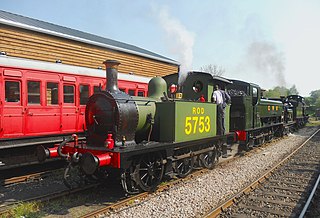
The Kent and East Sussex Railway (K&ESR) refers to both a historical private railway company in Kent and East Sussex in England, as well as a heritage railway currently running on part of the route of the historical company. The railway runs between Tenterden Town and Bodiam.
Appledore is a village and civil parish in the Ashford District of Kent, England. The village centre is on the northern edge of the Romney Marsh, 12 miles (19 km) south-west of Ashford town. The northerly part of this village is Appledore Heath.
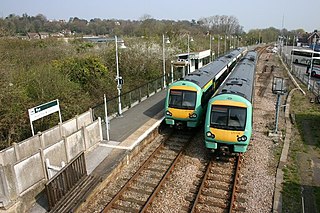
The Marshlink line is a railway line in South East England. It runs from Ashford, Kent via Romney Marsh, Rye and the Ore Tunnel to Hastings where it connects to the East Coastway line towards Eastbourne and Brighton.
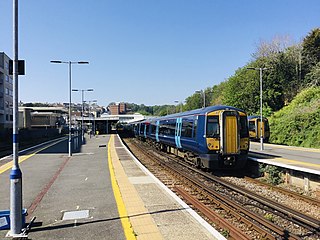
Hastings railway station is the southern terminus of the Hastings line in the south of England and is one of four stations that serve the town of Hastings, East Sussex. It is also on the East Coastway line to Eastbourne and the Marshlink line to Ashford International. It is 62 miles 33 chains (100.4 km) from London Charing Cross measured via Chelsfield and Battle; and 82 miles 33 chains (132.6 km) from Charing Cross via Chelsfield and Ashford.

The East Coastway line is a railway line along the south coast of Sussex to the east of Brighton, England. Trains to the west of Brighton operate on the West Coastway line. Together with the West Coastway and the Marshlink line to the east, the line forms part of a continuous route from Havant to Ashford. The Brighton Main Line route to Eastbourne and Hastings, via Plumpton and Cooksbridge, shares the East Coastway line east of Lewes station.

Ashford International railway station is a National Rail station in Ashford, Kent, England. It connects several railway lines, including High Speed 1 and the South Eastern Main Line. Services are operated by Southeastern and Southern.

The Hastings line is a secondary railway line in Kent and East Sussex, England, linking Hastings with the main town of Tunbridge Wells, and London via Tonbridge and Sevenoaks. Although primarily carrying passengers, the railway also serves a gypsum mine which is a source of freight traffic. Southeastern Trains operates passenger trains on the line, and it is one of their busiest lines.

Headcorn railway station is on the South Eastern Main Line in England, serving the village of Headcorn, Kent. It is 45 miles 20 chains (72.8 km) down the line from London Charing Cross. The station and all trains that serve the station are operated by Southeastern.

Bexhill railway station serves Bexhill-on-Sea in East Sussex, England. It is on the East Coastway Line, and train services are provided by Southern.

Ore railway station serves Ore in East Sussex, England. It is on the Marshlink Line, and train services are provided by Southern, with a single peak hour service operated by Southeastern.

Three Oaks railway station serves the village of Three Oaks, East Sussex, England. It is on the Marshlink line with all services operated by Southern. It was originally known as Three Oaks & Guestling.

Doleham railway station is a small, single-platform wayside halt in Doleham, East Sussex, England. It is on the Marshlink line, and train services are provided by Southern. The station is very isolated and serves only a handful of houses in the immediate area. There is an approximate daily figure of 8 passengers a day pre-covid.
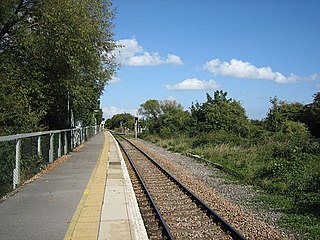
Winchelsea railway station is a railway station in East Sussex, England. It is about 0.62 miles (1 km) from Winchelsea and is actually in the neighbouring parish of Udimore. It is on the Marshlink line 9.3 miles (15 km) north east of Hastings, and train services are provided by Southern. The station originally had two platforms, but in 1979, the line was singled and only the up platform is now in use. The former down platform and station building are now converted to a private house.

Appledore railway station is a Grade II listed station east of Appledore in Kent, England. It is on the Marshlink line, and train services are provided by Southern.

Ham Street railway station is a Grade II listed stop on the Marshlink line in the village of Hamstreet, Kent, between Ashford International and Hastings. Services are provided by Southern.

Lewes railway station serves the town of Lewes in East Sussex, England. It has five platforms and is on the East Coastway Line, 49 miles 74 chains (80.3 km) from London Bridge via Redhill. Train services are provided by Southern.

Eastbourne railway station serves the seaside town of Eastbourne in East Sussex, England. It is on the East Coastway Line. The station is managed by Southern, who operate all trains serving it. It is one of two railway stations in the town, the other being Hampden Park Station. There are also two other stations in the Eastbourne area, one being Pevensey & Westham, in nearby Westham, the other being Polegate.

Polegate railway station serves Polegate in East Sussex, England. It is on the East Coastway Line, 61 miles 39 chains (99.0 km) from London Bridge, and train services are provided by Southern.
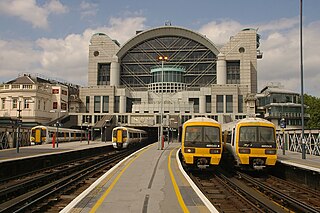
The South Eastern Main Line is a major long-distance railway route in South East England, UK, one of the three main routes crossing the county of Kent, going via Sevenoaks, Tonbridge, Ashford and Folkestone to Dover. The other routes are the Chatham Main Line which runs along the north Kent coast to Ramsgate or Dover via Chatham and High Speed 1 which runs through the centre of Kent to the coast at Folkestone where it joins the Channel Tunnel.

The Hawkhurst branch line was a short railway line in Kent that connected Hawkhurst, Cranbrook, Goudhurst and Horsmonden with the town of Paddock Wood and the South Eastern and Medway Valley lines, a distance of 11 miles 24 chains.

























